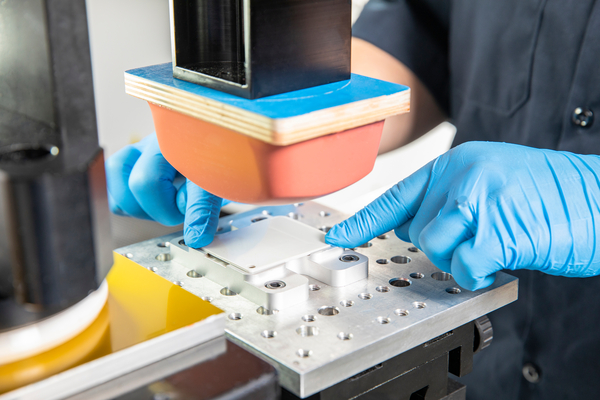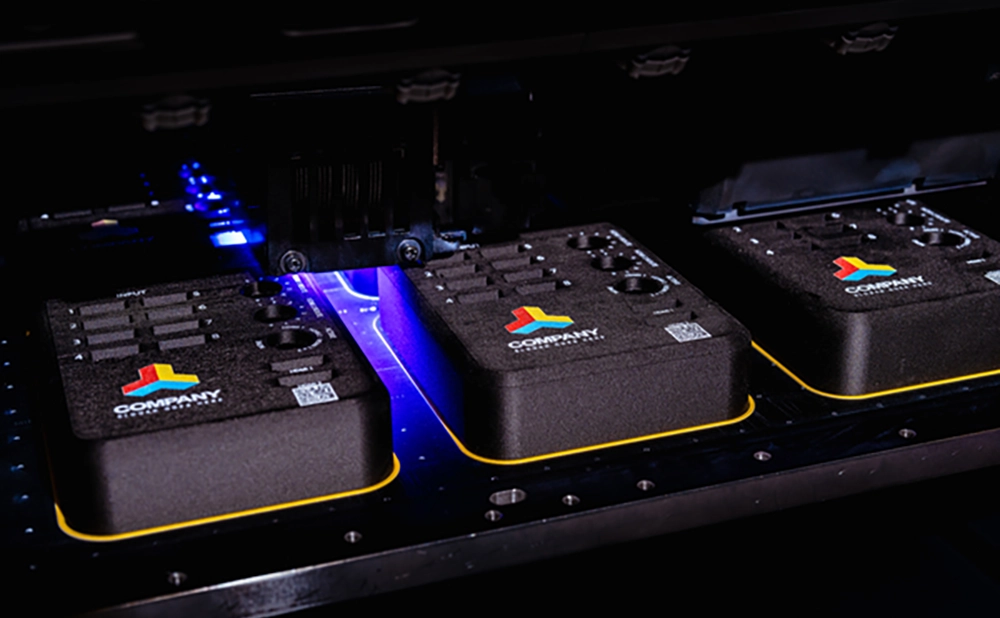Pad Printing vs UV Printing
Comparing Post-Processing Options for Molded Parts
What is Pad Printing?
Pad printing is an industrial printing process that uses a flexible, custom-shaped silicone pad to transfer an inked image from an etched metal or plastic plate called a cliché onto a surface. It was invented in the 1960s and has become ubiquitous as a printing method for most industries. Pad printing supports a wide range of solid colors, with precise Pantone matching commonly available through ink systems.

Advantages and Limitations of Pad Printing
Primary Applications of Pad Printing
What is UV Printing?

Advantages and Limitations of UV Printing
UV printing minimizes upfront setup—with no clichés or dedicated fixtures—so it’s well suited to quick iterations, frequent graphic changes, and small batches. It supports gradients and more complex imagery than pad printing. Results are consistent, and overall cost can be lower than pad printing for short runs. Because a physical cliché is not needed, UV printing allows for variable data such as serialization numbers.
UV printing does have some limitations as it can face adhesion challenges on rubbery substrates or with incompatible material chemistries. It shares similar size and curvature constraints with pad printing, in which graphics may distort if parts are too curved. In addition, primers or sealers may leave a slight texture on the surface, which could create an issue for parts that require an absolutely smooth finish. Because the output of a UV printer is dot-based (commonly up to 1200 DPI resolution), there can be a faint pixelation effect—though usually this is not visible to the human eye.
Finally, because UV printing is a newer technology than pad printing, some companies may be less comfortable using it.
Primary Applications for UV Printing
UV printing serves the same core needs as pad printing, such as marking, branding, and instructional text. It’s especially useful for creating gradient or photographic effects, which are popular in toys and consumer products, and for variable data applications such as serialization or versioning.
Design Considerations for Printing on Injection-Molded Parts
Both methods are sensitive to surface geometry: excessive curvature or deep recesses can stretch or degrade graphics, and maximum printable areas are similar. Material selection affects adhesion for either process, with rubbery substrates more challenging for both UV printing and pad printing. It’s best to stick with materials with proven results. Fixturing is typically required for pad printing due to physical contact, whereas UV printing usually does not, and UV prints may have a slightly more tactile feel.
When to Use Pad Printing vs. UV Printing
Choose pad printing when:
- Established standards specify pad printing
- Exact Pantone color matching and extreme smooth, crisp, solid graphics are the priority
- Setup costs can be spared over larger production runs
Choose UV printing when:
- Gradients or complex imagery are needed
- Printing variable data such as serialization and want fast changes with minimal setup
- Production small quantities or prototypes
| Need | Why | |
|---|---|---|
| Gradients or photographic effects | UV printing | Supports gradients and complex imagery via digital process |
| Exact Pantone-matched solid colors | Pad printing | Delivers precise solid-color matching and smooth fills |
| Small quantities or prototypes | UV printing | Minimal setup; fast, low-cost changeovers |
| Large, stable production runs | Pad printing | Higher setup amortized over volume; cost-competitive at scale |
| Variable data or serialization | UV printing | Easy to change artwork and print unique IDs per part |
| Fast turnaround without tooling | UV printing | No clichés/fixtures; rapid setup |
| Smoothest, least tactile surface | Pad printing | Typically leaves a smoother feel than UV (which can be slightly raised) |
| Tight brand color tolerance on solids | Pad printing | Excellent consistency for solid Pantone colors |
| Rubbery substrates or tricky chemistries | Pad printing (for testing) | UV adhesion can be challenging; pad and/or pretreatments may perform better—test first |
| High curvature or deep recesses | Neither ideal (evaluate) | Both have similar curvature/depth limits; consider redesign or alternative marking |
| Cost sensitivity on short runs | UV printing | Lower upfront cost; generally cheaper for small batches |
Contact us
